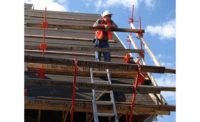What to do? First, basic first aid treatment calls for keeping the person with a nosebleed calm. Have them sit upright, lean slightly forward, and pinch the nostrils for five or ten minutes. Don't allow the person to clear their nose by blowing or removing clots. Applying ice (crushed in a plastic bag or washcloth) to the nose and cheeks may help stop the bleeding. Seek medical help if the nose continues to bleed after 10-15 minutes, if the bleeding is severe, or if the nosebleed is recurrent.
Following a nosebleed a person should avoid strenuous work for 24 to 48 hours, especially if it involves bending and lifting heavy objects. They should also refrain from consuming hot drinks, using alcohol or aspirin (Tylenol, Panadol or Anacin-3 is okay), or taking hot baths and showers for two days. During this two-day period they should also sleep with their head slighted elevated.
Check it out
Humidity is the first workplace factor to evaluate after a nosebleed. Tissue inside the nose can begin drying when the humidity level drops below 20 percent. Dried tissue makes the small blood vessels inside the nose easily subjected to trauma and subsequent bleeding.If employees work in dry air, they should be allowed to take periodic breaks, perhaps 20 minutes every two hours, in areas where the air is moist. If that's not possible, a pea size amount of Vaseline applied every two or three hours should keep tissue inside the nose moist.
Many chemicals can contribute to nosebleeds, but you'll rarely find this information on material safety data sheets. Look for chemicals known to damage nose tissue, cause drying or mechanical irritation, increase blood pressure, thin the blood, or that are severe pulmonary irritants.
Chromic acid and chromates are known to cause tissue damage to the septum inside the nose. Chemicals that may cause desiccation, dryness or mechanical irritation include kaolin, fiberglass, silica, and talc. Chemicals that may increase blood pressure include alpha-aminopryridine, carbon dioxide, dimethylformamide, diphenyl oxide, and sodium azide. Warfarin and various organic solvents are among chemicals that may thin the blood. Severe pulmonary irritants include ammonia, bromine, chlorine, hydrogen fluoride, formaldehyde, and nitric acid.
I wouldn't discount chemicals as a possible factor unless they were found at less than one-half of their permissible exposure limit (PEL), threshold limit value (TLV) or other recognized limit. Be sure to apply additive calculations and take one-half of unity when two or more chemicals are present. As mentioned, heavy bending and lifting may contribute to nosebleeds by increasing blood pressure for certain people. Continuous work without drinking fluids may cause a person to become dehydrated, increasing chances that the inside of the nose will become dry.
Psychological stress can also be a factor. Hormones released in response to strong stimuli such as fear, anger, appetite, thirst, and sexual activity cause nasal mucosal vessels to fill with blood, perhaps increasing the opportunity for nosebleeds. This explains why first aid treatment for nosebleeds includes keeping the person calm.
Generally, several factors (age, illness, medications, etc.) are necessary for a nosebleed to occur. Workplace conditions may well be among them. But there are steps we can take to limit or prevent work-related causes.



